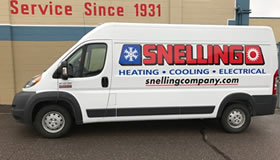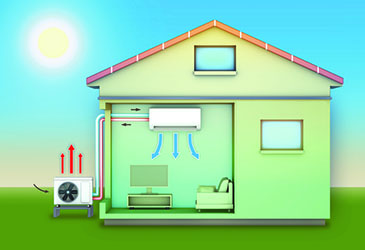Heat Pumps
If you are exploring options to heat and cool your home and reduce your energy bills, you should consider a heat pump system. Heat pumps are a proven and reliable technology, capable of providing year-round comfort control for your home by supplying heat in the winter, cooling in the summer.
Heat pumps are an excellent choice for both new homes and retrofits of existing heating and cooling systems. They are also an option when replacing existing air conditioning systems, as the incremental cost to move from a cooling-only system to a heat pump is often quite low. There are different system types and numerous options available, so it is best to consult with a professional like THE SNELLING COMPANY, when considering the installation of a heat pump or replacement of your current system.
Heat Pump Basics:
|
WINTER
Pumps heat from the outside to the inside. |
SUMMER
Pumps heat from the inside to the outside. |
Heat pumps are a proven technology that has been in use for decades. They can efficiently provide heating and cooling. In fact, it is likely that you interact with heat pump technology on a daily basis — like with refrigerators and air conditioners which operate using the same principles and technology. Below is helpful information about the basics of how a heat pump works and examples of different system types.
A heat pump is an electrically driven device that extracts heat from a low temperature place (the source) and delivers it to a higher temperature place (the sink). To understand this process, think about a bicycle ride over a hill: No effort is required to go from the top of the hill to the bottom, as the bike and rider will move naturally from a high place to a lower one. However, going up the hill requires a lot more work, as the bike is moving against the natural direction of motion.
In a similar manner, heat naturally flows from places with higher temperatures to locations with lower temperatures (e.g., in the winter, heat from inside the building is lost to the outside). A heat pump uses additional electrical energy to counter the natural flow of heat and pump the energy available in a colder place to a warmer one. So how does a heat pump heat or cool your home? As energy is extracted from a source, the temperature of the source is reduced. If the home is used as the source, thermal energy will be removed, cooling this space. This is how a heat pump operates in cooling mode, and is the same principle used by air conditioners and refrigerators. Similarly, as energy is added to a sink, its temperature increases. If the home is used as a sink, thermal energy will be added, heating the space. A heat pump is fully reversible, meaning that it can both heat and cool your home, providing year-round comfort.
Heat Pump Operation:
In Minnesota there are two commonly used types of heat pumps:
- A Standard Heat Pump System – is one that incorporates an outdoor heat pump paired with an electric furnace (fan coil w/electric heat). In this system, the heat pump always runs with each call for heat. As the heat pump capacity drops due to lower outdoor temperatures, electric heat is staged on with the heat pump.
- A Dual Fuel Heat Pump System – is one that incorporates an outdoor heat pump with a natural gas furnace. In this system, the heat pump and furnace operate together to keep the home at a constant temperature. When the heat pump can’t extract enough heat from the outside to meet the indoor temperature setting, there is a “switch over” to the gas furnace and the heat pump will shut off. This temperature setting is called the “balance point.”
Heat Pump Efficiency:
Furnaces and boilers provide space heating by adding heat to the air through the combustion of a fuel such as natural gas. While efficiencies have continually improved, they still remain below 100%, meaning that not all the available energy from combustion is used to heat the space.
Heat pumps operate on a different principle. The electricity input into the heat pump is used to transfer thermal energy between two locations. This allows the heat pump to operate more efficiently, with typical efficiencies well over 200%. Meaning more thermal energy is produced than the amount of electric energy used to pump it.
It is important to note that the efficiency of the heat pump depends greatly on the temperatures of the source. Just like a steeper hill requires more effort to climb on a bike, greater temperature differences between the source and sink of the heat pump require it to work harder and can reduce efficiency. Determining the right size of heat pump to maximize seasonal efficiencies is critical.
How heat pumps can help reduce carbon emissions:
Around 40% of global emissions come from buildings and most of these result from the ways we heat our homes and businesses. To lower carbon emissions, we can switch from heating that relies on high-carbon fuels to cleaner, low-carbon alternatives.
Heat pumps will help to achieve this for two main reasons:
Heat pump systems are designed to extract a greater amount of heat energy from the surrounding environment than the energy they consume to heat. They can produce two or three times more heat output than they consume in electricity input.
And as more and more electricity is generated from renewable energy sources like solar or wind power, the electricity used to power heat pumps is itself becoming cleaner.
A bonus for consumers:
Another reason to consider switching to a heat pump is the financial benefit. Due to the changes in state and federal regulations, an individual can qualify for up to $5,000 in rebates and tax credits by installing a new dual fuel heat pump system. These rebates make it more affordable to install a new heat pump system and help reduce your energy use. Don’t wait, call The Snelling Company today to get a FREE estimate on an energy efficient Heat Pump system for your home. Call 651-646-7381 or visit www.SnellingCompany.com today for your free in-home Heat Pump estimate.
Call and talk to the experts at SNELLING COMPANY today!
Request Appointment

"*" indicates required fields




